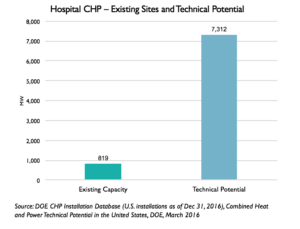By Alexandra Rekkas, Senior Research Associate, Alliance for Industrial Efficiency
Last week, Health Care Without Harm released an exciting new report—Safe haven in the storm: Protecting lives and margins with climate-smart health care—which demonstrates how hospitals can save lives and their money by investing in resilient energy technologies, such as combined heat and power (CHP).
Recent natural disasters—such as hurricanes Harvey, Irma, and Maria—have reaffirmed the importance of constructing more efficient and resilient energy systems, particularly for critical infrastructure. Because CHP systems can operate independently of the grid, they can keep the lights and power on during hurricanes, severe flooding, cyber incidents, and other states of emergency.
As the report details, Partners Healthcare, Massachusetts’ largest health system, had concerns about resiliency after Hurricane Katrina in 2006. Also, due to energy price fluctuations in 2008 and 2009, they had high energy bills, which led them to consider combined heat and power. Now, five of the system’s 13 hospitals have installed on-site CHP, among other resiliency measures. David Burson, a senior project manager at Partners HealthCare, said, “close to half of the $1.5 million we spent in resilience investments were recoverable through utility rebates, and, through our annual energy savings of $500,000, we recouped the remaining amount within 18 months.”
Similarly, Texas Medical Center (TMC) installed a 48 MW CHP system at their campus to improve resiliency. TMC’s resiliency investments were able to withstand Hurricane Rita in 2005, Hurricane Ike in 2008, and, most recently, Hurricane Harvey in 2017. During Hurricane Harvey, all hospitals and emergency rooms on the TMC campus stayed operational—a testament to their CHP system.
In 2013, the Department of Energy emphasized the potential role of CHP in “enabling energy resiliency for critical infrastructure” in the wake of Superstorm Sandy. DOE highlighted CHP systems that had enabled hospitals, universities, and important manufacturing sites to keep the lights on during extreme weather events. The new release from Healthcare without Harm reaffirms the value of this important technology.
While these snapshots provide an important reminder of CHP’s benefits and shine a spotlight on the forward-thinking hospitals that recognize them, they represent just a fraction of the opportunity. To date, roughly 200 hospitals across the country have installed CHP systems totaling 819 megawatts. According to DOE, the technical potential is nearly nine times that amount (Figure 1).
Learn more about several of these existing projects in Health Care Without Harm’s new report.

Read more about the opportunity for CHP in natural disaster mitigation in a new fact sheet from the Alliance.
